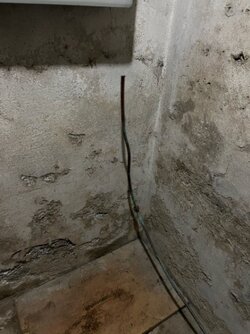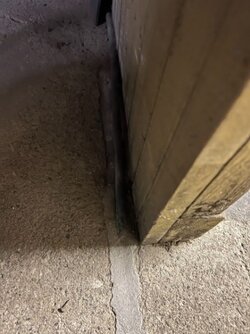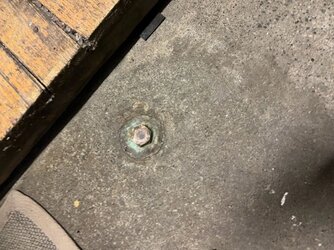Pretty simple, standard practice was to run the line from the bottom outlet of the oil tank to the oil burner so that it flowed via gravity to the pump integrated with the burner. The concern was that the copper line would get in the way on top of the floor so the line was poured into the floor to "protect it" Unfortunately, damp concrete over the years will corrode the copper and the oil could find its way under the floor. In many cases it was slow process that the homeowner did not notice and the line may leak for years or in other cases the homeowner would fill their tank in the fall and it would be out of fuel in few days. That heating oil under the slab would leak into the ground under the house and its a major environmental issue that can cost tens of thousands of dollars to mitigate.
Code now requires at a minimum that the line under the floor is replaced with a line coated with vinyl (usually orange) that is run above the floor. In other areas they require the tank to be changed out with double contained tank (Roth is the most well known brand, that is a plastic tank surrounded by galvanized secondary containment tank with a pop up alarm if the plastic tank leaks). In some case new steel oil tanks have a "double bottom" with a cavity and plug on the side that can be used to test if the bottom is leaking. Fuel oil is pulled out of the Roth type tank through the top and then run under the floor rafters to the oil boiler. In some cases there was return line from the oil boiler to purge air out of the piping but in most installs there is device call a Tiger Loop that can deal with air in the line. Those overhead installations without the TIger loop can be PITA to deal with if the homeowner lets the tank run dry.
In rare cases in older homes, the homeowners just ignored or did not know about leaks under the slab and some future homeowner gets a surprise as once an oil leak is discovered its got to be cleaned up. Some states put a surcharge on heating oil and have a clean up fund to subsidize the clean up of these leaks. In the majority of cases the oil system was replaced with natural gas and the copper was just cut off at the floor and plugged or in some cases just left there or tiled over. In some cases homes had buried steel tanks outside the basement and banks usually will not write mortgages unless the tanks are removed and the soil around them tested and cleaned. During the tight real estate market many homes were being sold "as is" and inspections were being skipped, no doubt some folks ended up with past oil leaks under the slab or in the yard.
When I built my house in 1987 they were still pouring lines in the floor. I ended up having a rigid PVC pipe poured into the floor and used that to pull the copper pipe through when I got around to installing a boiler.
For other readers who may still have heating oil,
Different states have different laws that may prevent the oil company from delivering oil unless the tanks and fuel lines have been upgraded. In others, heating oil tanks need to be replaced prior to a certain age. My parents dodged a bullet on their home, my mom mentioned she had smelled oil and found a few drops under the tank and had put a pan under it. It was a weekend so I told my parents to call the oil dealer first thing Monday morning. They sent a tech first thing and by noon they had brought a truck to pump the tank out and replace it. I did not see it taken out, but the tank looked perfectly good. When they removed it my dad was there and one of the techs took a screwdriver and stuck it in through the bottom of the tank without a lot of effort. In most cases if it leaks, everything in the basement has to be thrown away, any interior partitions/wall will need need to removed and if any oil got under the slab, a portion of the slab may need to be removed and any contaminated soil removed. In a friend's case, the state had to put in collection wells around a parent's house and pump and treat ground water collected from the wells and then treat it for over ten year until it tested clean.
Water collects in the bottom of the tanks over the years and rots them from the inside out. I have seen attempts to measure the tank bottom thickness but in my experience with industrial tanks, it is hard to find a thin spot as the corrosion is not uniform, it forms blisters at random locations and eats its way down. My tanks are getting old and I currently have a used Roth tank waiting for me to install. BTW the Roth type tanks take up less space than the standard 275 gallon steel tanks, they sit directly on the floor and are rectangular and sit taller.








